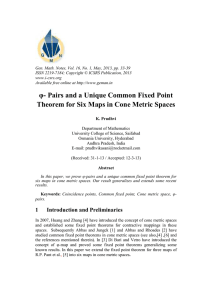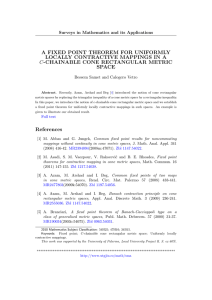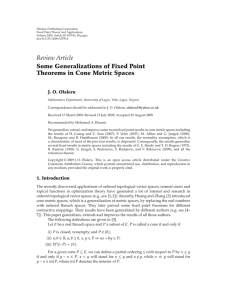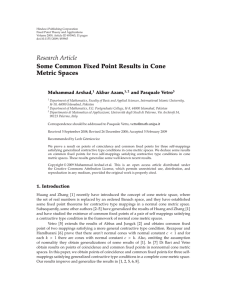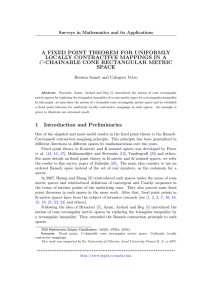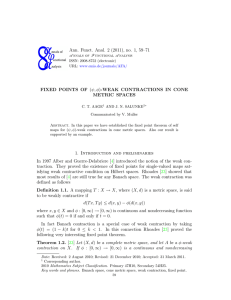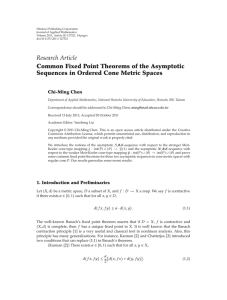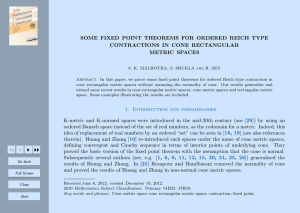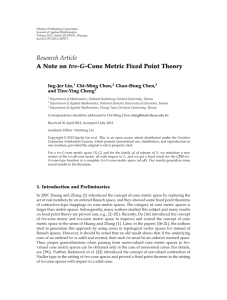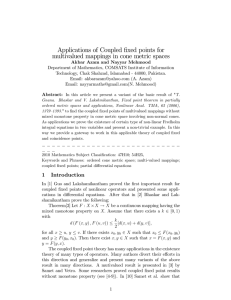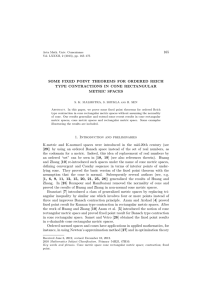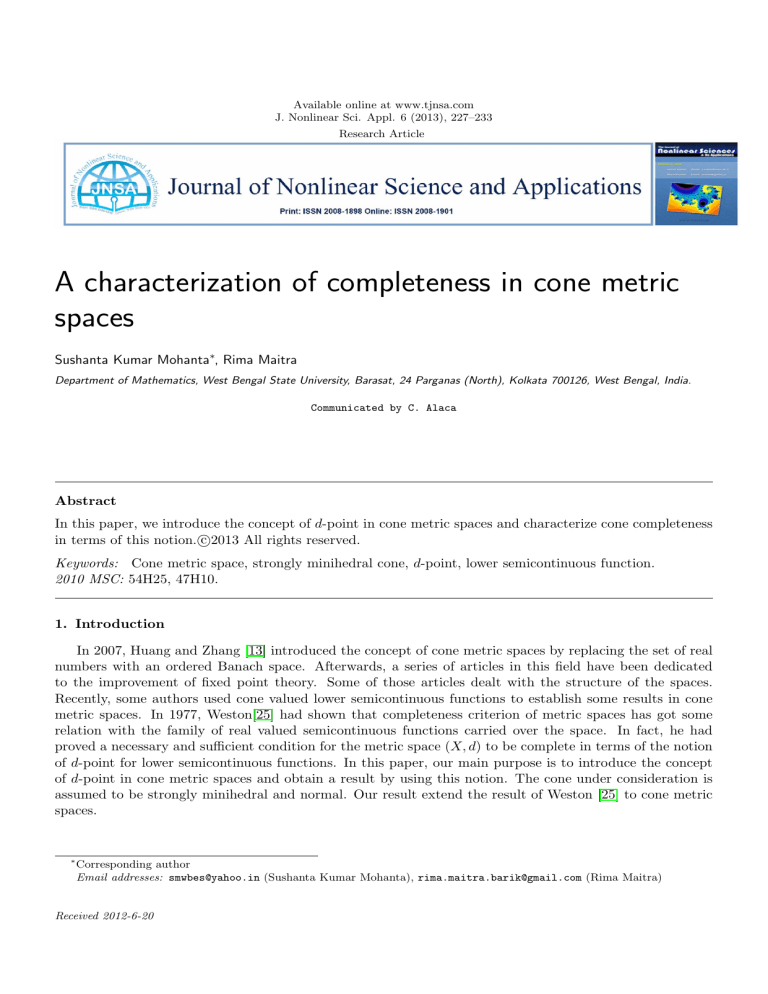
Available online at www.tjnsa.com
J. Nonlinear Sci. Appl. 6 (2013), 227–233
Research Article
A characterization of completeness in cone metric
spaces
Sushanta Kumar Mohanta∗, Rima Maitra
Department of Mathematics, West Bengal State University, Barasat, 24 Parganas (North), Kolkata 700126, West Bengal, India.
Communicated by C. Alaca
Abstract
In this paper, we introduce the concept of d-point in cone metric spaces and characterize cone completeness
in terms of this notion. c 2013 All rights reserved.
Keywords: Cone metric space, strongly minihedral cone, d-point, lower semicontinuous function.
2010 MSC: 54H25, 47H10.
1. Introduction
In 2007, Huang and Zhang [13] introduced the concept of cone metric spaces by replacing the set of real
numbers with an ordered Banach space. Afterwards, a series of articles in this field have been dedicated
to the improvement of fixed point theory. Some of those articles dealt with the structure of the spaces.
Recently, some authors used cone valued lower semicontinuous functions to establish some results in cone
metric spaces. In 1977, Weston[25] had shown that completeness criterion of metric spaces has got some
relation with the family of real valued semicontinuous functions carried over the space. In fact, he had
proved a necessary and sufficient condition for the metric space (X, d) to be complete in terms of the notion
of d-point for lower semicontinuous functions. In this paper, our main purpose is to introduce the concept
of d-point in cone metric spaces and obtain a result by using this notion. The cone under consideration is
assumed to be strongly minihedral and normal. Our result extend the result of Weston [25] to cone metric
spaces.
∗
Corresponding author
Email addresses: smwbes@yahoo.in (Sushanta Kumar Mohanta), rima.maitra.barik@gmail.com (Rima Maitra)
Received 2012-6-20
S. K. Mohanta, R. Maitra, J. Nonlinear Sci. Appl. 6 (2013), 227–233
228
2. Preliminaries
Let E be a real Banach space and P be a subset of E. Then P is called a cone if and only if
(i)
P is closed, nonempty and P 6= {θ};
(ii)
a, b ∈ R, a, b ≥ 0, x, y ∈ P ⇒ ax + by ∈ P ;
(iii)
P ∩ (−P ) = {θ}.
For a given cone P ⊆ E, we can define a partial ordering ≤ on E with respect to P by x ≤ y (equivalently,
y ≥ x) if and only if y − x ∈ P . We shall write x < y (equivalently, y > x) if x ≤ y and x 6= y, while
x y(equivalently, y x) will stand for y − x ∈ Int(P ), where Int(P ) denotes the interior of P . The cone
P is called normal if there is a number k > 0 such that for all x, y ∈ E,
θ ≤ x ≤ y implies kxk ≤ k kyk.
The least positive number satisfying the above inequality is called the normal constant of P .
The cone P is called regular if every increasing sequence which is bounded from above is convergent.
That is, if (xn ) is a sequence such that x1 ≤ x2 ≤ ··· ≤ xn ≤ ··· ≤ y for some y ∈ E, then there is x ∈ E such
that k xn − x k→ 0 (n → ∞). Equivalently the cone P is regular if and only if every decreasing sequence
which is bounded from below is convergent. Razapour and Hamlbarani [19] proved that every regular cone
is normal and there are no normal cones with normal constant k < 1.
Definition 2.1. [13] Let X be a nonempty set. Suppose the mapping d : X × X → E satisfies
(i) θ ≤ d(x, y) f or all x, y ∈ X and d(x, y) = θ if and only if x = y;
(ii) d(x, y) = d(y, x) f or all x, y ∈ X;
(iii) d(x, y) ≤ d(x, z) + d(z, y) f or all x, y, z ∈ X.
Then d is called a cone metric on X, and (X, d) is called a cone metric space.
Definition 2.2. [13] Let (X, d) be a cone metric space. Let (xn ) be a sequence in X and x ∈ X. If for
every c ∈ E with θ c there is a natural number n0 such that for all n > n0 , d(xn , x) c, then (xn ) is
said to be convergent and (xn ) converges to x, and x is the limit of (xn ). We denote this by lim xn = x or
n→∞
xn → x (n → ∞).
Definition 2.3. [13] Let (X, d) be a cone metric space, (xn ) be a sequence in X. If for any c ∈ E with
θ c, there is a natural number n0 such that for all n, m > n0 , d(xn , xm ) c, then (xn ) is called a Cauchy
sequence in X.
Definition 2.4. [13] Let (X, d) be a cone metric space, if every Cauchy sequence is convergent in X,
then X is called a complete cone metric space.
Lemma 2.5. [20] Let E be a real Banach space with a cone P . Then
(i) If a b and b c, then a c.
(ii) If a ≤ b and b c, then a c.
Lemma 2.6. [13] Let (X, d) be a cone metric space, P a normal cone with normal constant k, x ∈ X
and (xn ) a sequence in X. Then
(i) (xn ) converges to x if and only if d(xn , x) → θ(or equivalently, k d(xn , x) k→ 0);
(ii) Limit point of every sequence is unique;
(iii) Every convergent sequence is Cauchy;
(iv) (xn ) is a Cauchy sequence if and only if d(xn , xm ) → θ as n, m → ∞ (or equivalently, k d(xn , xm ) k→ 0);
(v) If xn → x and yn → y, then d(xn , yn ) → d(x, y) as n → ∞.
S. K. Mohanta, R. Maitra, J. Nonlinear Sci. Appl. 6 (2013), 227–233
229
Lemma 2.7. [13] Let (X, d) be a cone metric space over a cone P in E. Then one has the following.
(i) Int(P ) + Int(P ) ⊆ Int(P ) and λ Int(P ) ⊆ Int(P ), λ > 0.
(ii) If c θ, then there exists δ > 0 such that kbk < δ implies b c.
(iii) For any given c θ and c0 θ there exists n0 ∈ N such that nc00 c.
(iv) If an , bn are sequences in E such that an → a, bn → b and an ≤ bn for all n ≥ 1, then a ≤ b.
Proposition 2.8. [14] If E is a real Banach space with cone P and if a ≤ λa where a ∈ P and 0 ≤ λ < 1
then a = θ.
Definition 2.9. [12] P is called minihedral cone if sup{x, y} exists for all x, y ∈ E, and strongly minihedral if every subset of E which is bounded from above has a supremum or equivalently, every subset of E
which is bounded from below has an infimum.
It is easy to see that every strongly minihedral normal cone is regular.
Definition 2.10. [1] Let (X, d) be a cone metric space and ϕ : X → E a function on X. Then, the
function ϕ is called a lower semicontinuous on X whenever
lim xn = x =⇒ ϕ(x) ≤ lim inf ϕ(xn ) := sup inf ϕ(xm ).
n→∞
n→∞
n≥1 m≥n
Definition 2.11. Let (X, d) be a cone metric space and f : X → E. Then, the function f is called
uniformly continuous on X if for any > 0 there is a c ∈ E with θ c such that
d(x, y) c =⇒ kf (x) − f (y)k < .
3. Main Results
In this section we always suppose that E is a real Banach space, P is a cone in E with Int(P ) 6= ∅ and ≤
is the partial ordering on E with respect to P . Throughout the paper we denote by N the set of all natural
numbers.
We begin with a definition.
Definition 3.1. Let (X, d) be a cone metric space and h : X → E. A point x0 ∈ X is called a d-point
for h if for every other point x ∈ X with h(x0 ) − h(x) ∈ Int(P ),
h(x0 ) − h(x) < d(x0 , x)
Example 3.2. Let E = R2 , P = {(x, y) ∈ R2 : x, y ≥ 0}, X = {(x, 0) ∈ R2 : 0 ≤ x ≤ 1} ∪ {(0, x) ∈ R2 :
0 ≤ x ≤ 1} and d : X × X → E be such that
4
d ((x, 0), (y, 0)) =
| x − y |, | x − y | ,
3
2
d ((0, x), (0, y)) = | x − y |, | x − y | ,
3
4
2
d ((x, 0), (0, y)) = d ((0, y), (x, 0)) =
x + y, x + y .
3
3
S. K. Mohanta, R. Maitra, J. Nonlinear Sci. Appl. 6 (2013), 227–233
230
Then (X, d) is a cone metric space.
We define h : X → E by
y h((x, 0)) = (0, x), h((0, y)) = − , 0 .
2
Then,
y 1
1
y 1
− − ,0 =
∈ Int(P ) f or y > 0,
h ( , 0) − h((0, y)) = 0,
,
2
2
2
2 2
1
1
1
h ( , 0) − h((y, 0)) = 0,
− (0, y) = 0, − y 6∈ Int(P ).
2
2
2
Also, for y > 0
1
1
y 1
< d ( , 0), (0, y) .
h ( , 0) − h((0, y)) =
,
2
2 2
2
Thus, ( 21 , 0) is a d-point for h.
Theorem 3.3. Let (X, d) be a complete cone metric space and let P be a strongly minihedral normal
cone of comparable elements. Then any lower semicontinuous function h : X → E which is bounded below
has a d-point. If (X, d) is not complete, then there is a uniformly continuous function g : X → E which is
bounded below but has no d-point.
Proof. For any point x1 ∈ X, we construct a sequence (xn ) in the following way:
For each n ∈ N, let
α(xn ) = inf {h(x) : h(xn ) − h(x) ≥ d(xn , x) > θ}.
h being bounded below, α(xn ) exists by strong minihedrality of P .
Let xn+1 be a point such that
h(xn ) − h(xn+1 ) ≥ d(xn , xn+1 )
(3.1)
and
c0
, where c0 ∈ Int(P ).
(3.2)
n
It follows from (3.1) that the sequence (h(xn )) is nonincreasing in E. Also, it is bounded below. Since
P is regular, the sequence (h(xn )) is convergent.
For m ≥ n, the triangle inequality implies that
h(xn+1 ) < α(xn ) +
h(xn ) − h(xm ) = h(xn ) − h(xn+1 ) + h(xn+1 ) − h(xn+2 )
+ · · · +h(xm−1 ) − h(xm )
≥ d(xn , xn+1 ) + d(xn+1 , xn+2 ) + · · · + d(xm−1 , xm )
≥ d(xn , xm ).
(3.3)
Hence,
k d(xn , xm )k ≤ k k h(xn ) − h(xm )k → 0 as m, n → ∞.
By Lemma 2.6, k d(xn , xm ) k→ 0 yields that the sequence (xn ) is Cauchy in X. Completeness of X implies
that the sequence (xn ) is convergent to some point in X, say x0 . From (3.3), it follows that
h(xm ) ≤ h(xn ) − d(xn , xm )
(3.4)
for all m ≥ n. By regarding (3.4), Lemma 2.6 and lower semicontinuity of the function h, one can obtain
that
h(x0 ) ≤
≤
lim inf h(xm )
m→∞
lim inf [h(xn ) − d(xn , xm )]
m→∞
= h(xn ) − d(xn , x0 )
S. K. Mohanta, R. Maitra, J. Nonlinear Sci. Appl. 6 (2013), 227–233
231
for all n ≥ 1. Thus,
h(xn ) − h(x0 ) ≥ d(xn , x0 )
(3.5)
for all n ≥ 1.
If x0 is not a d-point for h, then for some x(6= x0 ) ∈ X with h(x0 ) − h(x) ∈ Int(P ),
h(x0 ) − h(x) ≥ d(x0 , x) > θ.
(3.6)
Using (3.5) and (3.2), we obtain
h(x) ≤ h(xn+1 ) + h(x) − h(x0 ) < α(xn ) +
c0
+ h(x) − h(x0 ).
n
(3.7)
Since θ c0 and θ h(x0 ) − h(x), by Lemma 2.7, there exists n ∈ N such that
c0
h(x0 ) − h(x)
n
which implies that h(x0 ) − h(x) − cn0 ≥ θ. Thus, (3.7) gives that h(x) < α(xn ).
From (3.5) and (3.6), it follows that
h(xn ) − h(x) = h(xn ) − h(x0 ) + h(x0 ) − h(x)
≥ d(xn , x0 ) + d(x0 , x)
> θ
which implies that h(xn ) > h(x). So, xn 6= x and therefore d(xn , x) > θ.
Moreover,
h(xn ) − h(x) ≥ d(xn , x0 ) + d(x0 , x) ≥ d(xn , x) > θ.
It now follows from the definition of α(xn ) that h(x) ≥ α(xn ) which contradicts the fact that h(x) < α(xn ).
Thus, x0 is a d-point for h.
Now suppose that (X, d) is not complete. So there exists a Cauchy sequence (xn ) in X which is not
convergent. We show that for any x ∈ X, the sequence (2d(x, xn )) is Cauchy in E.
For x ∈ X, we have
d(x, xn ) ≤ d(x, xm ) + d(xm , xn )
and so
d(x, xn ) − d(x, xm ) ≤ d(xm , xn ).
(3.8)
Interchanging n and m, we obtain
d(x, xm ) − d(x, xn ) ≤ d(xm , xn ).
By hypothesis, the elements of P are comparable. Then either d(x, xn ) ≤ d(x, xm ) or d(x, xm ) ≤ d(x, xn ).
Without loss of generality, we may assume that d(x, xm ) ≤ d(x, xn ) and so from (3.8), we have
θ ≤ d(x, xn ) − d(x, xm ) ≤ d(xm , xn ).
If k is the normal constant of P , then
k2d(x, xn ) − 2d(x, xm )k ≤ k k2d(xm , xn )k → 0 as m, n → ∞
which implies that (2d(x, xn )) is Cauchy in E. By completeness of E, let g(x) be its limit. Clearly, g(x) > θ.
Because g(x) = θ implies that the sequence (xn ) is convergent, a contradiction.
S. K. Mohanta, R. Maitra, J. Nonlinear Sci. Appl. 6 (2013), 227–233
232
Thus, the function g is bounded below.
If x0 ∈ X, then
g(x0 ) − g(x) =
=
≤
lim 2d(x0 , xn ) − lim 2d(x, xn )
n→∞
n→∞
lim [2d(x0 , xn ) − 2d(x, xn )]
n→∞
lim 2d(x0 , x)
n→∞
= 2d(x0 , x).
(3.9)
Interchanging x0 and x, we obtain
g(x) − g(x0 ) ≤ 2d(x0 , x).
Since the elements of P are comparable, either g(x0 ) ≤ g(x) or g(x) ≤ g(x0 ). Suppose that g(x) ≤ g(x0 ).
Then using (3.9), we have
θ ≤ g(x0 ) − g(x) ≤ 2d(x0 , x)
which implies that
kg(x0 ) − g(x)k ≤ k k2d(x0 , x)k.
Let > 0 be a given real number. We choose c ∈ E with θ c and k 2 kck < . Then,
c
c
kg(x0 ) − g(x)k ≤ 2k 2 k k whenever d(x0 , x) 2
2
c
< whenever d(x0 , x) .
2
So, g is uniformly continuous. Also,
i
1
1h
[g(x0 ) + g(x)] =
lim 2d(x0 , xn ) + lim 2d(x, xn )
n→∞
2
2 n→∞
≥ d(x0 , x).
Now,
1
1
[g(x0 ) + g(x)] + [g(x0 ) − 3g(x)]
2
2
1
≥ d(x0 , x) + [g(x0 ) − 3g(x)] .
(3.10)
2
If g(x0 ) − g(x) ∈ Int(P ), then g(x) g(x0 ). Again, g(x) > θ. So, it must be the case that θ g(x0 ). By
the definition of g, 3g(xm ) → θ as m → ∞.
By Lemma 2.7, for g(x0 ) ∈ E with θ g(x0 ), there is δ > 0 such that kbk < δ implies g(x0 ) − b ∈ Int(P ).
Since 3g(xm ) → θ as m → ∞, for this δ there is n0 ∈ N such that k3g(xm )k < δ for all m > n0 . So,
g(x0 ) − 3g(xm ) ∈ Int(P ) for all m > n0 i.e., 3g(xm ) g(x0 ) for all m > n0 . Thus, 3g(x) g(x0 ) if x = xm
and m is large. It now follows from (3.10) that g(x0 ) − g(x) ≥ d(x0 , x) if x = xm and m is large. So, x0 is
not a d-point for g.
g(x0 ) − g(x) =
The following Corollary is the result [[25], Theorem].
Corollary 3.4. If the metric space (X, d) is complete then any lower semicontinuous function X → R
which is bounded below has a d-point. If (X, d) is not comlete there is a uniformly continuous function
X → R which is bounded below but has no d-point.
Proof. Taking E = R, P = [0, ∞) in Theorem 3.3, the conclusion of the Corollary follows.
Remark 3.5. Theorem 3.3 is an extension of the result [[25], Theorem] in metric spaces to cone metric
spaces.
S. K. Mohanta, R. Maitra, J. Nonlinear Sci. Appl. 6 (2013), 227–233
233
Acknowledgements:
The authors are very grateful to the referees for their valuable suggestions.
References
[1] T. Abdeljawad, E. Karapinar, Quasicone metric spaces and generalizations of Caristi Kirk’s theorem, Fixed Point
Theory and Applications (2009), Article ID 574387, 9 pages. 2.10
[2] M. Abbas, G. Jungck, Common fixed point results for noncommuting mappings without continuity in cone metric
spaces, J. Math. Anal. Appl. 341 (2008), 416-420.
[3] M. Arshad, A. Azam, I. Beg, Common fixed points of two maps in cone metric spaces, Rend. Circ. Mat. Palermo
57 (2008), 433-441.
[4] M. Arshad, A. Azam, P. Vetro, Some common fixed point results in cone metric spaces, Fixed Point Theory Appl.
(2009), Article ID 493965, 11 pages.
[5] A. Azam, M. Arshad, I. Beg, Common fixed point theorems in cone metric spaces, J. Nonlinear Sci. Appl. 2
(2009), 204-213.
[6] C. Di Bari, P. Vetro, ϕ-Pairs and common fixed points in cone metric spaces, Rendiconti del Circolo Matematico
di Palermo 57 (2008), 279-285.
[7] C. Di Bari, P. Vetro, Weakly ϕ-Pairs and common fixed points in cone metric spaces, Rendiconti del Circolo
Matematico di Palermo 58 (2009), 125-132.
[8] C. Di Bari, R. Saadati and P. Vetro, Common fixed points in cone metric spaces for CJM-pairs, Math. Comput.
Modelling 54 (2011), 2348-2354.
[9] C. Di Bari, P. Vetro, Common fixed points in cone metric spaces for MK-pairs and L-pairs, Ars Combin 99
(2011), 429-437.
[10] I. Beg, M. Abbas, Coincidence point and invariant approximation for mappings satisfying generalized weak contractive condition, Fixed Point Theory and Applications (2006), Article ID 74503, 7 pages.
[11] I. Beg, M. Abbas, T. Nazir, Generalized cone metric spaces, J. Nonlinear Sci. Appl. 3 (2010), 21-31.
[12] K. Deimling, Nonlinear Functional Analysis, Springer, Berlin, Germany, 1985. 2.9
[13] L.-G. Huang, X. Zhang, Cone metric spaces and fixed point theorems of contractive mappings, J. Math. Anal.
Appl. 332 (2007), 1468-1476. 1, 2.1, 2.2, 2.3, 2.4, 2.6, 2.7
[14] D. Ilić, V. Rakočević, Common fixed points for maps on cone metric space, J. Math. Anal. Appl. 341 (2008),
876-882. 2.8
[15] Sh. Jain, Sh. Jain, L. Bahadur Jain, On Banach contraction principle in a cone metric space, J. Nonlinear Sci.
Appl. 5 (2012), 252-258.
[16] Z. Kadelburg and S. Radenovic, Some common fixed point results in non-normal cone metric spaces, J. Nonlinear
Sci. Appl. 3 (2010), 193-202.
[17] J. O. Olaleru, Some generalizations of fixed point theorems in cone metric spaces, Fixed Point Theory and
Applications (2009), Article ID 657914, 10 pages.
[18] B. E. Rhoades, Some theorems on weakly contractive maps, Nonlinear Analysis: Theory, Methods and Applications 47 (2001), 2683-2693.
[19] S. Rezapour, R. Hamlbarani, Some notes on the paper ”Cone metric spaces and fixed point theorems of contractive
mappings”, J. Math. Anal. Appl. 345 (2008), 719-724. 2
[20] S. Rezapour, M. Derafshpour, R. Hamlbarani, A review on topological properties of cone metric spaces, in Proceedings of the Conference on Analysis, Topology and Applications (ATA’08), Vrnjacka Banja, Serbia, May-June
2008. 2.5
[21] F. Sabetghadam, H. P. Masiha, Common fixed points for generalized ϕ-pair mappings on cone metric spaces,
Fixed Point Theory and Applications (2010), Article ID 718340, 8 pages.
[22] B. Samet, Cirics fixed point theorem a cone metric space, J. Nonlinear Sci. Appl. 3 (2010), 302-308.
[23] P. Vetro, Common fixed points in cone metric spaces, Rend. Circ. Mat. Palermo 56 (2007), 464-468.
[24] P. Vetro, A. Azam, M. Arshad, Fixed point results in cone metric spaces, Int. J. Modern Math. 5 (2010), 101-108.
[25] J. D. Weston, A Characterization of metric completeness, Proc. Amer. Math. Soc., 64 (1977), 186-188.

